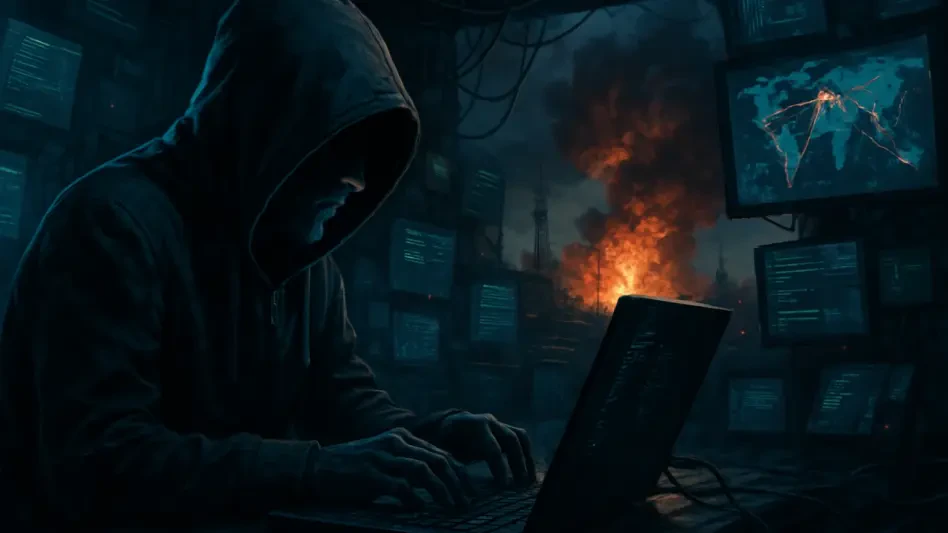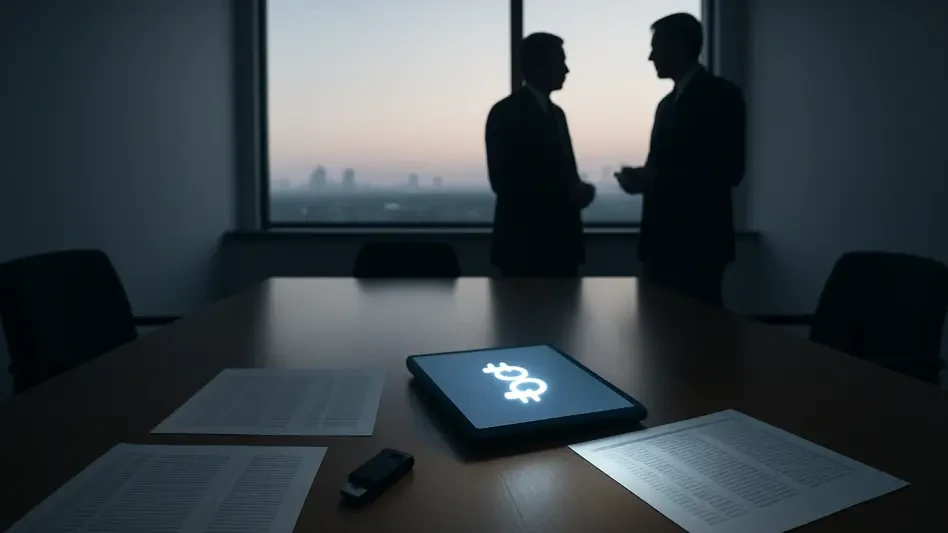In an era where digital battlegrounds are as critical as physical ones, the emergence of non-state cyber actors has profoundly disrupted the traditional legal structures that govern armed conflict, notably the Law of Armed Conflict (LOAC). These entities, often operating outside the bounds of state control, wield significant influence in modern warfare through sophisticated cyber operations that can cripple infrastructure or destabilize economies without firing a single shot. A striking case is that of Predatory Sparrow, a hacking group active during the 12-Day War between Iran and Israel, whose actions have spotlighted glaring ambiguities in how LOAC applies to such actors. Their operations, targeting key financial systems, raise pressing questions about whether existing legal categories—designed for state-centric conflicts—can adequately address the shadowy realm of non-state cyber warfare. This exploration delves into the challenges of fitting groups like Predatory Sparrow into LOAC’s framework, examining their legal status, the complexities of detention and prosecution, and the wider implications for international law in the digital age. As cyber conflicts grow in frequency and impact, the need to adapt legal norms to these new realities becomes increasingly urgent, prompting a critical reassessment of how global rules of engagement must evolve to maintain relevance and ensure accountability in an ever-changing technological landscape.
Unraveling the Legal Status of Cyber Entities
The legal status of non-state cyber actors under LOAC presents a labyrinth of uncertainty that challenges the very foundations of international humanitarian law. Groups like Predatory Sparrow, which operate with apparent independence from state authority, do not fit neatly into the conventional categories of combatants or civilians as defined by treaties such as the Third Geneva Convention (GC III). Public evidence suggests that this hacking group lacks the formal affiliation with a state like Israel that would qualify its members as a militia entitled to prisoner of war (POW) status if captured. Instead, potential classifications include civilians directly participating in hostilities (DPH) or unprivileged belligerents within a non-state organized armed group (OAG). Each designation carries distinct legal ramifications, affecting rights and protections under LOAC. The ambiguity is further deepened by a lack of consensus among nations on whether unprivileged belligerents constitute a recognized category in international armed conflicts (IACs). While some states, including the United States, acknowledge this status and permit status-based targeting and detention, others adhere to a strict binary of combatants and civilians, granting the latter protections under the Fourth Geneva Convention (GC IV) unless they engage in hostile acts. This fragmented legal landscape creates significant hurdles in determining how to treat cyber actors who operate in virtual spaces with unclear ties to traditional military structures.
Beyond the theoretical classifications, the practical implications of status ambiguity for non-state cyber actors are profound and far-reaching. For entities like Predatory Sparrow, the absence of a clear legal standing under LOAC means that their members face unpredictable consequences if apprehended during a conflict. If deemed civilians engaging in DPH, they temporarily lose protection from attack and could be subject to internment under stringent conditions, but they retain certain safeguards under GC IV. Conversely, classification as unprivileged belligerents could strip them of most protections, allowing for indefinite detention with minimal legal oversight beyond basic humane treatment standards. The challenge lies not only in the differing state interpretations but also in the nature of cyber operations themselves, which often conceal organizational details and affiliations. Without transparent indicators of structure or command—common in physical warfare—ascertaining whether a group meets the criteria for an OAG under LOAC remains elusive. This uncertainty underscores a critical gap in international law, where the digital domain’s anonymity and decentralized nature clash with frameworks designed for more tangible and state-centric conflicts, leaving both actors and states in a precarious legal limbo.
Navigating Detention Standards in Cyber Conflicts
When considering the detention of non-state cyber actors, the legal basis for such actions under LOAC hinges critically on how their status is determined, revealing stark contrasts in potential outcomes. If a member of a group like Predatory Sparrow were captured, perhaps by Iranian forces during a conflict like the 12-Day War, their treatment would vary dramatically based on whether they are classified as civilians or unprivileged belligerents. As civilians engaging in DPH, they would fall under the protections of GC IV, meaning internment would only be permissible if deemed absolutely necessary for the security of the detaining power. This classification mandates rigorous due process, including periodic reviews to ensure that detention remains justified, reflecting a commitment to humanitarian principles even in the context of hostilities. Such safeguards aim to prevent arbitrary or prolonged confinement, ensuring that individuals are not stripped of fundamental rights simply for participating in conflict through digital means. However, the application of these rules to cyber actors is untested in many jurisdictions, raising questions about how states might interpret “security necessity” when the threat is virtual rather than physical, and whether existing legal mechanisms can adapt to these novel circumstances.
In stark contrast, if classified as unprivileged belligerents, members of non-state cyber groups could face far harsher detention conditions with significantly fewer protections under LOAC. This status would permit their confinement for the entire duration of a conflict without formal charges, subject only to the minimal humane treatment standards outlined in Common Article 3 of the 1949 Geneva Conventions. The disparity in treatment highlights the high stakes of status determination, particularly for cyber actors whose actions often lack the overt military characteristics of traditional combatants. Additionally, practical challenges compound the issue, especially in proving membership in an OAG within the cyber domain. Unlike physical armed groups, cyber entities often operate with anonymity, relying on virtual coordination that obscures traditional indicators such as a visible command hierarchy or geographic base. The Tallinn Manual 2.0 offers some guidance, suggesting that a cyber group qualifies as organized if it can sustain military operations through an established structure, but disagreements persist on whether purely virtual organizations meet this threshold. These unresolved issues illustrate the urgent need for clearer legal standards to address the unique nature of detention in cyber warfare, ensuring that humanitarian protections keep pace with technological realities.
Prosecuting Cyber Actions under International Law
The prosecution of non-state cyber actors under LOAC introduces a complex web of legal and practical challenges that test the boundaries of accountability in modern warfare. For groups like Predatory Sparrow, neither classification as civilians engaging in DPH nor as unprivileged belligerents grants immunity from domestic criminal prosecution for their participation in hostilities or breaches of cybercrime laws. States like Iran, targeted by such groups during conflicts, could pursue charges under national legal systems for actions that disrupt critical infrastructure or financial systems. Under LOAC, private actors are not prohibited from engaging in conflict, but they are bound by the same conduct-of-hostilities rules as formal combatants. This means that violations—such as targeting civilian objects or causing disproportionate harm—could potentially lead to accountability for war crimes if the actions meet the necessary legal thresholds. However, the cyber context complicates this framework, as the intangible nature of digital operations often falls outside traditional definitions of warfare, leaving prosecutors to navigate uncharted territory in proving intent, impact, and jurisdiction over elusive actors who may operate across multiple borders.
Further complicating the prosecution landscape are the unresolved questions surrounding the characterization of cyber operations under LOAC, which directly impact the potential for criminal liability. A key debate centers on whether specific cyber activities qualify as “attacks” within the meaning of international humanitarian law. While there is broad agreement among states that LOAC applies to cyber warfare, and that cyber tools can constitute means and methods of conflict, consensus breaks down over operations that do not cause physical destruction. For instance, actions that disrupt functionality—such as temporarily disabling a financial system—may not meet the criteria for an “attack” in the view of some nations, while others advocate for a broader interpretation that includes intangible harms. This lack of uniformity creates significant hurdles in establishing accountability, particularly for non-state actors whose operations often straddle the line between military and civilian impact. As international bodies like the International Criminal Court (ICC) begin to explore cyber-enabled crimes, the need for a harmonized legal approach becomes evident, ensuring that prosecution mechanisms can effectively address the unique challenges posed by digital warfare without undermining fundamental principles of justice.
Analyzing Specific Cyber Operations through LOAC
The cyber operations attributed to Predatory Sparrow during the 12-Day War offer a compelling case study in the difficulties of applying LOAC to non-state actors in the digital domain. Two notable actions stand out: the targeting of Bank Sepah, Iran’s largest financial institution, which resulted in widespread service outages and disrupted payment processing for critical services like gas stations, and the attack on Nobitex, the country’s leading cryptocurrency exchange, which saw $90 million drained and sensitive data exposed. While both entities are presumptively civilian, their alleged connections to Iranian military or Revolutionary Guard activities raise questions about whether they could be considered legitimate military objectives under LOAC. However, the operations did not cause physical destruction, instead focusing on functional disruption and data manipulation. This distinction lies at the heart of a broader legal debate about whether such actions meet the threshold of an “attack” as defined by international humanitarian law. The lack of physical harm challenges traditional interpretations, leaving these incidents in a gray zone where legal accountability under LOAC remains uncertain, even as their real-world impacts are undeniable.
Diving deeper into the legal analysis, the operations by Predatory Sparrow underscore two pivotal and unresolved issues in LOAC’s application to cyber warfare: the definition of an “attack” and the status of digital data as a protected “object.” On the first issue, states remain divided, with some requiring physical harm or death for an operation to qualify as an attack, while others, like France, adopt a wider view that includes loss of functionality or significant disruption. The second issue—whether digital data can be considered an object under targeting rules—further complicates matters. The majority perspective in the Tallinn Manual 2.0 holds that data, being intangible, does not qualify as an object, meaning its destruction might not violate LOAC prohibitions on attacking civilian entities. Yet, dissenting views argue that essential civilian data should fall under protective rules, reflecting a growing recognition of digital assets’ importance. Predatory Sparrow’s actions, particularly the draining of cryptocurrency funds without physical impact, sit squarely in this legal ambiguity, highlighting the urgent need for states to reconcile these differences. Without clearer definitions, the ability to hold non-state cyber actors accountable under international law will remain limited, risking unchecked escalation in digital conflicts.
Exploring the Wider Impact of Cyber Gray Zones
The rise of non-state cyber actors in modern conflicts has given birth to expansive “gray zones” within LOAC, where legal clarity on critical issues like status, detention, and accountability remains frustratingly elusive. Groups like Predatory Sparrow exemplify how the privatization of warfare through digital means challenges the state-centric design of international humanitarian law. Their ability to conduct sophisticated operations remotely blurs the once-clear lines between civilian and military roles, creating a battlespace where traditional distinctions no longer hold. This civilianization of conflict increases risks to civilian infrastructure, as financial systems, utilities, and personal data become targets in ways that LOAC struggles to address. The anonymity and global reach of cyber actors further exacerbate these challenges, making it difficult for states to attribute actions, enforce laws, or protect non-combatants from harm. As digital warfare becomes more prevalent, these gray zones threaten to undermine the protective intent of LOAC, leaving both states and individuals vulnerable to the unchecked consequences of cyber operations that fall outside established legal norms.
Addressing the broader implications of these gray zones requires acknowledging the limitations of current legal frameworks and the pressing need for adaptation to digital realities. Efforts by organizations such as the International Committee of the Red Cross (ICRC) to develop guidelines for civilian hackers represent a positive step toward mitigating risks, but their impact remains uncertain without widespread state adoption. The evolving nature of cyber warfare demands more than incremental adjustments; it calls for a concerted international effort to update LOAC, ensuring it can effectively govern non-state actors in virtual conflicts. States must prioritize consensus on key issues, such as the definition of cyber attacks and the protection of digital assets, to close existing gaps. Failure to act risks perpetuating a legal vacuum where accountability is sporadic, and civilian harm is inevitable. Looking back, the discourse around groups like Predatory Sparrow revealed a critical juncture where the international community grappled with technology’s rapid outpacing of law. The path forward involves strengthening global dialogue, fostering agreements on cyber norms, and integrating technological expertise into legal reforms to safeguard stability in an increasingly digitized world.








